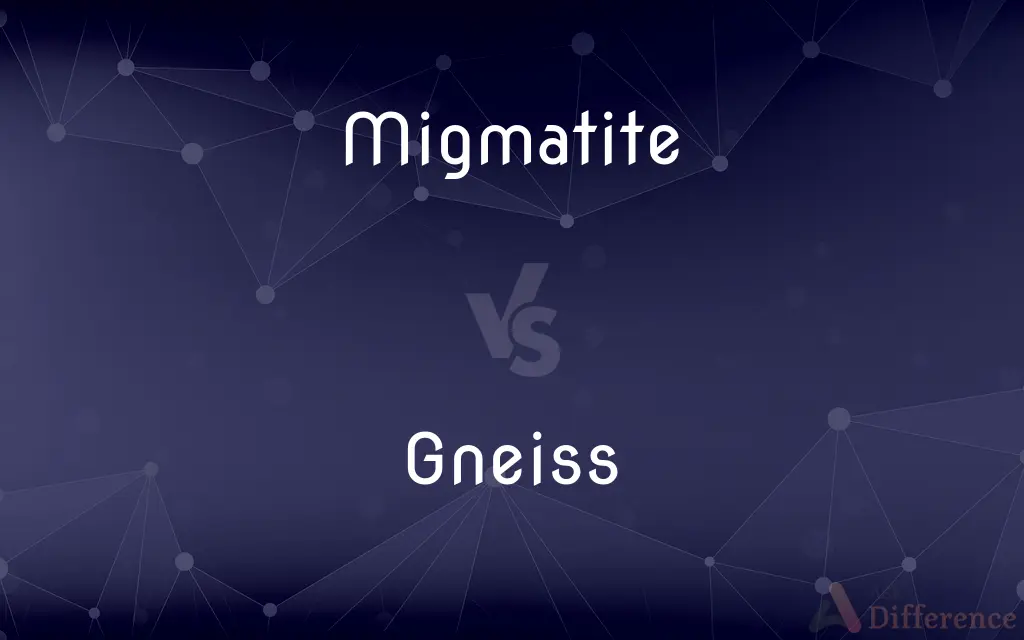Migmatite vs. Gneiss — What's the Difference?
By Tayyaba Rehman & Urooj Arif — Updated on April 3, 2024
Migmatite is a rock formed under extreme temperature and pressure, featuring both igneous and metamorphic qualities, whereas gneiss is a high-grade metamorphic rock with pronounced banding from mineral segregation.

Difference Between Migmatite and Gneiss
Table of Contents
ADVERTISEMENT
Key Differences
Migmatite is a composite rock that exhibits characteristics of both igneous and metamorphic rocks, created under conditions of high temperature and pressure that partially melt the rock. This partial melting results in the formation of features such as leucosomes (light bands) and melanosome (dark bands), indicative of its mixed origin. On the other hand, gneiss is a metamorphic rock that has undergone intense heat and pressure, leading to the alignment and segregation of its minerals into light and dark bands, known as gneissic banding. Unlike migmatite, gneiss does not typically contain evidence of partial melting.
The process of migmatization, which leads to the formation of migmatites, involves temperatures high enough to partially melt the rock, allowing for the coexistence of solid and liquid rock phases. This process gives migmatite its distinctive appearance and mixed rock type characteristics. In contrast, the formation of gneiss involves metamorphic processes that rearrange the minerals without melting them, resulting in a strong foliation and the characteristic banded appearance due to mineral segregation but without the presence of a melted phase.
Migmatites are often found in areas subjected to extreme metamorphic conditions, such as the edges of high-grade metamorphic zones where the temperature was sufficient to initiate partial melting. These conditions are typically associated with mountain-building regions where tectonic plates collide. Gneiss, while also indicative of high-grade metamorphic conditions, is more widely distributed and can be formed from a variety of parent rocks, including granite, shale, and volcanic rocks, through a process of high-pressure and temperature but without the melting involved in migmatite formation.
In terms of geological significance, migmatites provide important evidence about the conditions of the Earth’s crust at the time of their formation, particularly regarding the temperature and pressure conditions that can lead to partial melting. They can indicate the presence of geothermal gradients and tectonic activity that were conducive to such extreme conditions. Gneiss, with its pronounced banding and foliation, also provides valuable information about the metamorphic history of an area, including the direction and intensity of the pressures that led to its formation.
Migmatites and gneisses are both used as decorative stones, thanks to their unique and visually appealing textures. However, the presence of igneous features in migmatites can make them particularly attractive for certain architectural applications, offering a distinct pattern not found in purely metamorphic rocks like gneiss. Despite this, gneiss, with its strong banding and range of colors, remains a popular choice for countertops, facades, and other architectural elements where the beauty and strength of natural stone are desired.
ADVERTISEMENT
Comparison Chart
Rock Type
Composite (Metamorphic and Igneous)
Metamorphic
Formation Process
Partial melting due to extreme temperature and pressure
Intense heat and pressure without melting
Characteristics
Leucosomes and melanosome, indicating mixed origin
Pronounced mineral banding without evidence of melting
Geological Significance
Indicates conditions for partial melting of Earth’s crust
Indicates high-grade metamorphic conditions and history
Usage
Decorative stone for its unique texture
Widely used as a decorative stone for countertops and facades
Compare with Definitions
Migmatite
A composite rock formed under extreme conditions, showing characteristics of both igneous and metamorphic rocks.
The migmatite displayed a beautiful mix of light and dark bands, showcasing its complex formation history.
Gneiss
A high-grade metamorphic rock characterized by its pronounced banding from mineral segregation.
The gneiss’s distinct banding was the result of extreme pressure and temperature over millions of years.
Migmatite
Results from partial melting of the rock under high temperature and pressure.
In the migmatite, the leucosomes represented areas where the rock had partially melted.
Gneiss
Formed through intense heat and pressure, causing the segregation of minerals into bands.
The dark and light bands in the gneiss were due to the rearrangement of its mineral components.
Migmatite
Provides evidence of the Earth’s crust conditions that can lead to partial melting.
Studying migmatites helps geologists understand past geothermal gradients and tectonic activities.
Gneiss
Known for its gneissic banding without evidence of partial melting.
The gneiss exhibited a striking pattern of mineral banding, a testament to its metamorphic origins.
Migmatite
Features leucosomes and melanosome, indicative of its igneous and metamorphic qualities.
The geologist pointed out the migmatite's distinct bands, highlighting its mixed origin.
Gneiss
Indicates the direction and intensity of pressures during its formation.
Geologists study gneiss to gain insights into the metamorphic processes of the Earth’s crust.
Migmatite
Valued as a decorative stone due to its unique texture and appearance.
The architect chose migmatite for the lobby's flooring to add an element of natural beauty and complexity.
Gneiss
Popular as a decorative stone, especially for countertops and facades.
Gneiss was the chosen material for the kitchen countertops, adding both durability and elegance.
Migmatite
Migmatite is a composite rock found in medium and high-grade metamorphic environments. It consists of two or more constituents often layered repetitively; one layer was formerly paleosome, a metamorphic rock that was reconstituted subsequently by partial melting; the alternate layer has a pegmatitic, aplitic, granitic or generally plutonic appearance.
Gneiss
Gneiss ( nyse) is a common and widely distributed type of metamorphic rock. Gneiss is formed by high-temperature and high-pressure metamorphic processes acting on formations composed of igneous or sedimentary rocks.
Migmatite
A rock of both metamorphic and igneous origin that exhibits characteristics of both rock types and probably forms through the heating but not melting of rocks in the presence of abundant fluids.
Gneiss
A banded or foliated metamorphic rock, usually of the same composition as granite.
Migmatite
(geology) Any rock of mixed appearance, being an intimate mixture of granite and older rock, specifically from intense metamorphism which partially melts the rock, causing it to recrystallize in a state intermediate between igneous and metamorphic.
Gneiss
(geology) A common and widely-distributed metamorphic rock having bands or veins, but not schistose.
Gneiss
A crystalline rock, consisting, like granite, of quartz, feldspar, and mica, but having these materials, especially the mica, arranged in planes, so that it breaks rather easily into coarse slabs or flags. Hornblende sometimes takes the place of the mica, and it is then called hornblendic gneiss or syenitic gneiss. Similar varieties of related rocks are also called gneiss.
Gneiss
A laminated metamorphic rock similar to granite
Common Curiosities
What makes migmatite unique among rocks?
Migmatite is unique due to its dual igneous and metamorphic characteristics, evidenced by its partial melting.
Where is migmatite typically found?
Migmatite is typically found in high-grade metamorphic zones, often near tectonic plate boundaries.
What is the significance of gneiss in geology?
Gneiss is significant for revealing the high-grade metamorphic conditions and history of an area.
Can migmatite be used in outdoor architecture?
Yes, migmatite can be used in outdoor architecture, where its unique appearance adds aesthetic value.
Does migmatite formation occur at specific depths?
Migmatite formation typically occurs at depths where extreme temperature and pressure conditions are present.
How does the texture of migmatite compare to that of gneiss?
Migmatite’s texture can be more varied due to its mixed origin, while gneiss has a more uniform, banded texture.
How do the formation conditions of migmatite and gneiss differ?
Migmatite forms under conditions that allow partial melting, whereas gneiss forms under high pressure and temperature without melting.
What are the parent rocks for gneiss?
Gneiss can form from a variety of parent rocks, including granite, shale, and volcanic rocks.
Is gneiss stronger than migmatite?
Both rocks are strong, but their structural integrity may vary depending on the specific conditions of their formation.
How can you identify gneiss?
Gneiss can be identified by its pronounced banding and foliation, resulting from the segregation of its mineral components.
How do the geological processes that form migmatite and gneiss contribute to our understanding of the Earth’s crust?
These processes provide insights into the temperature, pressure, and tectonic activities that shape the Earth’s crust over time.
Why is gneiss commonly used in construction and decorative applications?
Gneiss is popular in construction and decorative applications due to its durability, distinctive banding, and aesthetic appeal.
Can migmatite and gneiss form next to each other?
Yes, migmatite and gneiss can form in proximity, especially in regions experiencing high-grade metamorphism.
What does the presence of leucosomes in migmatite indicate?
The presence of leucosomes in migmatite indicates areas where the rock has undergone partial melting.
What are the common uses of migmatite in the construction industry?
Migmatite is used for decorative purposes, such as in flooring, wall cladding, and as accent pieces.
Share Your Discovery

Previous Comparison
Lobby vs. Solicit
Next Comparison
Performance vs. RecitalAuthor Spotlight
Written by
Tayyaba RehmanTayyaba Rehman is a distinguished writer, currently serving as a primary contributor to askdifference.com. As a researcher in semantics and etymology, Tayyaba's passion for the complexity of languages and their distinctions has found a perfect home on the platform. Tayyaba delves into the intricacies of language, distinguishing between commonly confused words and phrases, thereby providing clarity for readers worldwide.
Co-written by
Urooj ArifUrooj is a skilled content writer at Ask Difference, known for her exceptional ability to simplify complex topics into engaging and informative content. With a passion for research and a flair for clear, concise writing, she consistently delivers articles that resonate with our diverse audience.













































